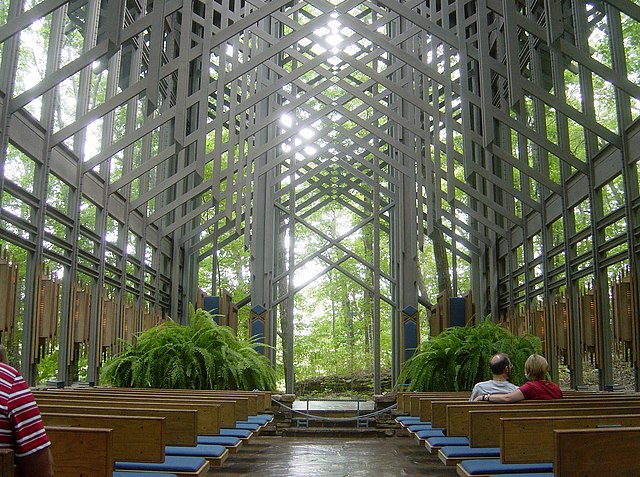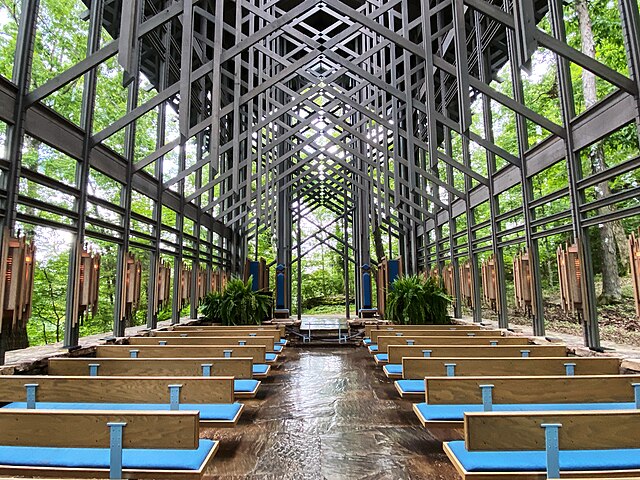Have you ever wondered what it would feel like to pray inside a kaleidoscope? Welcome to Thorncrown Chapel, where architecture becomes poetry and nature transforms into your cathedral ceiling. Nestled in the Ozark Mountains of Arkansas, this isn’t just another pretty building – it’s a masterpiece that has been making visitors weep with joy for over four decades.
What Makes Thorncrown Chapel So Special?
Picture this: you’re walking through a dense Arkansas forest when suddenly, like something from a fairy tale, a structure of glass and timber emerges from the trees. Thorncrown Chapel doesn’t just sit in the landscape – it becomes part of it, breathing with the seasons and dancing with the light.
This isn’t your grandmother’s traditional church. With 425 windows creating walls of pure transparency, the chapel dissolves the boundary between indoor and outdoor worship. When sunlight filters through the towering glass panels, it creates a natural stained-glass effect that changes throughout the day. It’s like God decided to build his own greenhouse, and honestly, the results are spectacular.
A Vision Born from Nature
The chapel’s design philosophy is beautifully simple: why compete with nature when you can celebrate it? Every element of Thorncrown Chapel was crafted to enhance rather than overshadow the natural beauty of the Ozark wilderness. The result? A space where you can feel equally connected to the divine and to the earth beneath your feet.
Architectural Marvel Meets Spiritual Sanctuary
What happens when you combine Frank Lloyd Wright’s organic architecture principles with a deep reverence for nature? You get Thorncrown Chapel – a space that proves modern architecture can be both innovative and deeply spiritual. The chapel doesn’t shout its presence; instead, it whispers an invitation to pause, reflect, and reconnect.
The Story Behind the Glass: How Thorncrown Chapel Came to Be

Every great building has an origin story, and Thorncrown’s tale is as inspiring as the structure itself. It’s a story of vision, perseverance, and the magic that happens when the right people come together at the right time.
Jim Reed’s Dream in the Ozark Mountains
In the 1970s, Jim Reed owned a plot of land in the Arkansas wilderness and had a simple yet profound dream: to create a space where people could experience the divine through nature. He didn’t want to build just any church – he wanted something that would honor both God and the incredible natural beauty of the Ozarks.
Reed’s vision was revolutionary for its time. While most religious buildings turned inward, creating sacred spaces separate from the world, Reed imagined something different: a chapel that would open itself completely to the natural world, making the forest itself part of the worship experience.
E. Fay Jones: The Architect Who Made Magic
Enter E. Fay Jones, a former student of Frank Lloyd Wright who understood that great architecture isn’t about imposing human will on nature – it’s about finding harmony between the built and natural environments. Jones took Reed’s vision and transformed it into something even more beautiful than either man had initially imagined.
Jones didn’t just design a building; he crafted an experience. Every angle, every beam placement, every window was carefully considered to maximize the chapel’s connection to its forest setting. The result was a structure that seems to have grown from the earth itself, as organic as the trees surrounding it.
Thorncrown Chapel’s Breathtaking Architecture
Let’s talk about what makes this place architecturally extraordinary. Thorncrown Chapel is 48 feet tall, 24 feet wide, and 60 feet long – dimensions that might seem modest until you step inside and feel the soaring space above you.
Glass, Wood, and Stone: Materials That Sing
The chapel’s material palette reads like a love letter to the Arkansas landscape. Native stone anchors the structure to the earth, while locally sourced pine creates the soaring framework. But it’s the glass – oh, that glorious glass – that transforms the ordinary into the transcendent.
The 425 Windows That Frame Heaven
Those 425 windows aren’t just architectural elements – they’re portals to wonder. During spring, they frame the tender green of new leaves. In summer, they create a canopy of deep forest green. Fall turns the chapel into a jewel box of gold and crimson, while winter reveals the elegant bones of the surrounding trees.
Each window is strategically placed to capture and reflect light in ways that change throughout the day. Morning light creates soft, contemplative shadows, while afternoon sun transforms the space into a cathedral of golden warmth. It’s like having a different chapel for every hour of the day.
Soaring Timber Framework
The wooden framework isn’t just structural – it’s sculptural. The beams rise and intersect in patterns that echo both gothic architecture and forest canopies. Looking up, you might see cathedral vaulting or the branching of ancient oaks. The ambiguity is intentional and beautiful.
How the Chapel Blends with Nature
This is where Thorncrown Chapel truly shines. The building’s footprint was deliberately kept small to minimize environmental impact. Construction materials were carried to the site by hand to avoid damaging the surrounding forest. Even the chapel’s height was designed to complement, not compete with, the towering oak and hickory trees.
The genius lies in how the structure seems to disappear into its environment. From certain angles, the glass walls become nearly invisible, making the wooden framework appear to float among the trees like some kind of architectural magic trick.
Planning Your Visit to Thorncrown Chapel
Ready to experience this marvel for yourself? Here’s everything you need to know to make your visit perfect.
Best Times to Visit
While Thorncrown Chapel is beautiful year-round, each season offers its own unique magic. Spring visitors are treated to the tender greens of new growth filtering through the glass walls. Summer brings lush, deep forest views and excellent weather for exploring the surrounding area.
Fall, however, might just be the most spectacular time to visit. The Arkansas Ozarks explode in autumn colors, and experiencing this natural fireworks display from inside the glass chapel is truly unforgettable. Winter offers its own stark beauty, with bare tree branches creating intricate patterns against gray skies.
For the ultimate experience, try to visit during the golden hour – that magical time just before sunset when the light turns warm and honey-colored. The chapel becomes absolutely luminous, and you’ll understand why so many visitors describe their experience as transcendent.
What to Expect During Your Visit
Thorncrown Chapel operates as both a tourist destination and an active place of worship. The space is open to visitors most days, but it’s always wise to check their schedule before making the trip. Non-denominational services are held regularly, and visitors of all faiths (or no faith at all) are welcome to attend.
The visit typically begins with a short walk through the forest to reach the chapel – this approach is part of the experience, creating anticipation and helping you transition from the everyday world to something more sacred. Once inside, most visitors find themselves naturally drawn to quiet contemplation.
Photography Guidelines and Etiquette
Photography is generally permitted, but remember that this is first and foremost a sacred space. Be respectful of others who may be in prayer or meditation. Flash photography is discouraged as it can be disruptive, but honestly, the natural light is so beautiful that you won’t need it anyway.
The best photos capture the interplay between the architectural elements and the natural surroundings. Try shooting from different angles to capture how the chapel seems to merge with the forest. And don’t forget to put the camera down sometimes – some experiences are best absorbed rather than captured.
Weddings at Thorncrown Chapel: A Dream Come True
If you’re planning a wedding and want something truly extraordinary, Thorncrown Chapel might just be your perfect venue. This isn’t your typical church wedding – it’s something far more magical.
Why Couples Choose This Sacred Space
Imagine exchanging vows surrounded by 425 windows that frame the Arkansas wilderness like a living painting. The chapel provides an intimate setting for up to 100 guests, creating a sense of closeness while the soaring architecture adds grandeur to the occasion.
The natural beauty surrounding the chapel means minimal decoration is needed – the forest provides the most stunning backdrop imaginable. Whether you’re planning a spring ceremony with fresh blooms visible through every window or a fall wedding surrounded by fiery autumn colors, nature becomes your wedding decorator.
Booking Your Special Day
Thorncrown Chapel is one of Arkansas’s most popular wedding venues, so booking well in advance is essential. The chapel staff can provide information about preferred vendors, photographers familiar with the space, and logistics for your special day.
Many couples choose to have both their ceremony and reception photos taken in the surrounding forest, creating a cohesive aesthetic that celebrates the natural beauty of the location. The nearby town of Eureka Springs offers plenty of options for reception venues and guest accommodations.
Beyond Thorncrown: Exploring Eureka Springs

Your visit to Thorncrown Chapel is the perfect excuse to explore one of Arkansas’s most charming destinations. Eureka Springs is a Victorian-era town that seems frozen in time, offering a delightful contrast to the chapel’s modern architecture.
Victorian Charm Meets Natural Beauty
Eureka Springs built its reputation as a healing destination thanks to its natural springs, and the town has maintained that wellness focus to this day. The entire downtown area is listed on the National Register of Historic Places, with Victorian homes and buildings creating a storybook atmosphere.
The town offers everything from antique shopping and art galleries to natural springs and hiking trails. It’s the kind of place where you can spend hours wandering, discovering hidden courtyards and unexpected vistas around every corner.
Where to Stay and Dine
Eureka Springs offers accommodations ranging from historic bed and breakfasts to modern hotels. Many visitors prefer staying in one of the town’s charming Victorian inns, which provide an authentic period experience that complements a visit to Thorncrown Chapel.
The dining scene in Eureka Springs is surprisingly sophisticated for such a small town. From farm-to-table restaurants showcasing Arkansas ingredients to cozy cafes perfect for a post-chapel meal, you’ll find plenty of options to satisfy any culinary craving.
Awards and Recognition
Thorncrown Chapel’s architectural significance has been recognized with numerous prestigious awards. The American Institute of Architects named it one of the top buildings of the 20th century – pretty impressive company for a small chapel in the Arkansas woods.
The chapel has also been featured in countless architectural publications and documentaries, cementing its status as one of America’s most significant religious buildings. But perhaps the most meaningful recognition comes from the millions of visitors who have found peace, inspiration, and renewal within its glass walls.
Conclusion
Thorncrown Chapel proves that great architecture doesn’t need to be massive or ostentatious to be powerful. Sometimes, the most profound experiences come from spaces that know exactly what they are and embrace it completely. This glass cathedral in the Arkansas wilderness has been touching hearts and inspiring souls for over 40 years, and it shows no signs of losing its magic.
Whether you’re seeking spiritual renewal, architectural inspiration, or simply a moment of peace in our chaotic world, Thorncrown Chapel offers something truly special. It’s a place where human creativity and natural beauty combine to create something greater than the sum of its parts – a space that reminds us of the power of thoughtful design and the enduring appeal of connecting with something larger than ourselves.
In a world of virtual experiences and digital connections, Thorncrown Chapel offers something increasingly rare: a physical space that demands your presence, rewards your attention, and leaves you changed. It’s not just a destination – it’s a transformation waiting to happen.
FAQs
1. How much does it cost to visit Thorncrown Chapel?
Admission to Thorncrown Chapel is free, though donations are gratefully accepted to help maintain this architectural treasure. The chapel operates on the principle that spiritual and architectural beauty should be accessible to everyone, regardless of financial means.
2. Can I get married at Thorncrown Chapel if I’m not religious?
Absolutely! Thorncrown Chapel welcomes couples of all faiths and backgrounds. While it’s a sacred space, it’s non-denominational and has hosted weddings for people with diverse spiritual beliefs. The focus is on celebrating love in a beautiful, meaningful setting.
3. Is Thorncrown Chapel wheelchair accessible?
The chapel has made efforts to accommodate visitors with mobility challenges, including accessible parking and pathways. However, given its forest location and the nature of the original construction, some areas may present challenges. It’s best to contact the chapel directly to discuss specific accessibility needs.
4. How long should I plan to spend at Thorncrown Chapel?
Most visitors spend 30-60 minutes at the chapel itself, though many find themselves staying longer simply to soak in the peaceful atmosphere. If you’re combining your visit with exploration of Eureka Springs, plan for a full day to really experience the area.
5. Are there guided tours available at Thorncrown Chapel?
While formal guided tours aren’t always available, knowledgeable staff members are often present who can share insights about the chapel’s history and architecture. The best approach is to arrive with an open heart and let the space speak for itself – sometimes the most profound experiences come from quiet personal reflection rather than structured tours.

